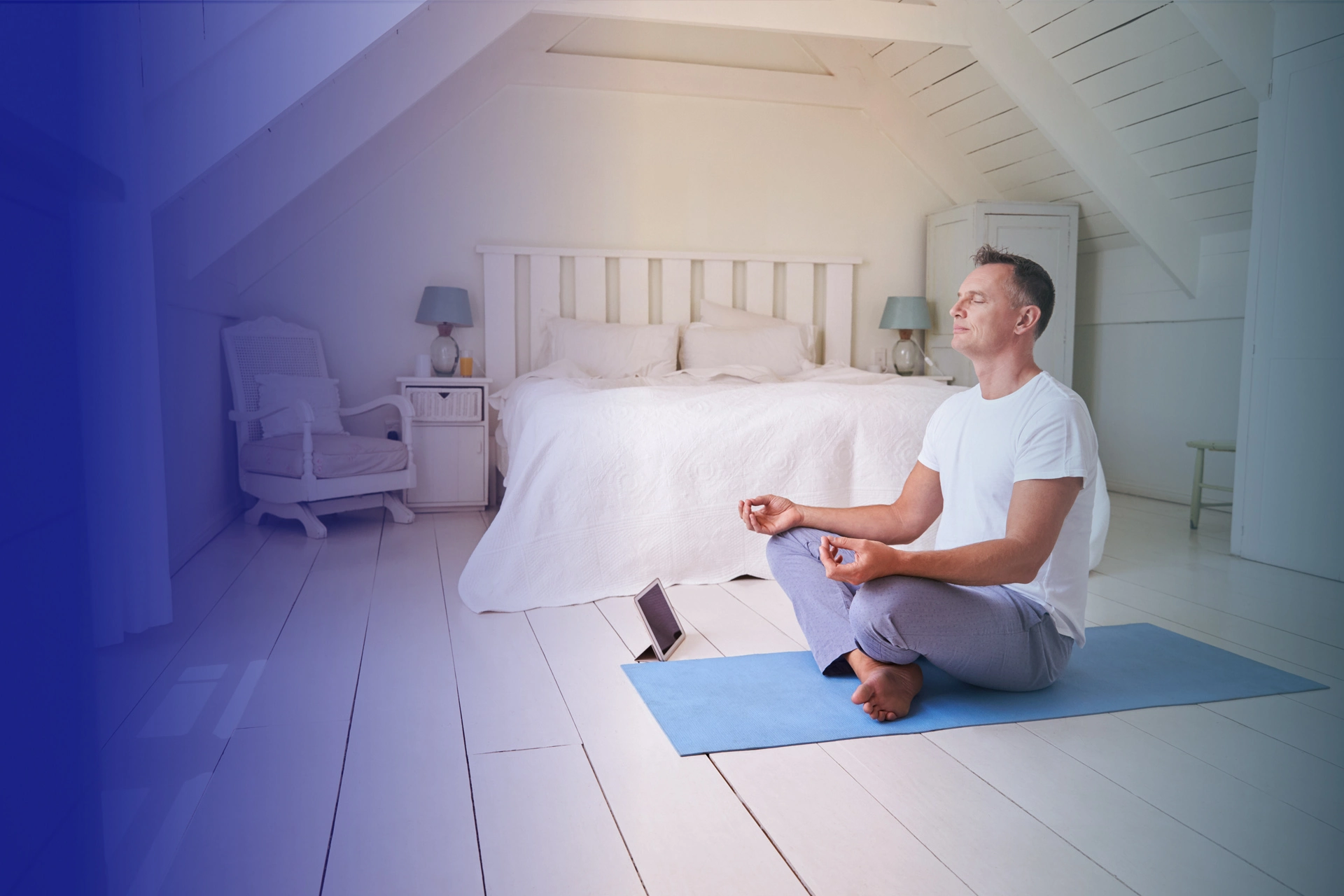
Table Of Content
As awareness around mental health moves further up the agenda in numerous countries around the world, so do methods for helping yourself to stay calm, handle negative thoughts and build up resilience for dealing with whatever life decides to throw at us. Actively seeking to look after our mental health is no longer shrouded in quite so much stigma, and this is a very good thing.
Men in particular have historically found it much harder to admit to feeling anxious or concerned about their wellbeing to their friends, family or health professionals. The idea that we must be tough and never cry still remains deep in our psyche and this can cause damage if left unchecked. Meditation is an easily accessible, highly effective way to help us relax, destress and re-centre our thoughts.
It can also help to aid sleep, enhance memory and focus and even boost the digestive and immune systems as your body resets itself and lets go of stress that can manifest itself physically as well as in the mind. Maybe it’s time to look more closely at the art and practice of meditation for men.
Meditation has been around for thousands of years, dating back to origins around 1500 BC in India. It grew into an intrinsic part of Buddhism, Taoism and Hinduism and is still seen today as a vital aspect of spirituality for followers of these religions, as well as others. Buddhism sees mediation, for example, as one of the main trainings that lead to the sought-after ‘enlightenment’, or awakening, and the ability to see the world for what it really is.
Although meditation has its origins in the East, it moved West around the 19th Century, thanks to improved methods of transportation opening up travel possibilities and opportunities to more traders and tourists. It really caught Westerners’ imagination in the mid-20th Century, popularised by students of Eastern culture and history who learned the many benefits of regular meditation for themselves. It has become popular amongst people seeking to strengthen their mental health, discover more about themselves and get away from the relentlessness of a full and hectic working life.
Despite its extensive history, meditation is still quite a mysterious concept for many men and it can seem daunting to undertake. It can seem like a more ‘female only’ thing to do. Men can also be put off by thoughts of having to wear special clothing, go to specially adapted rooms, listen to whale music and light candles to do it ‘properly’.
This is absolutely not the case. Meditation guidance states that it can be done by anyone of any age, alone or with other people as you prefer. You should wear clothes that you feel comfortable in and meditate somewhere quiet where you can feel safe and warm and will not be interrupted. Candles are not compulsory, although their soft, flickering light, warmth and gentle fragrance can help some people focus better on the whole process. Whale music is most definitely optional!
Men meditation techniques can be considered as a workout for the mind and soul. Just like a physical workout, it should leave you feeling invigorated and like you have worked hard to improve yourself in some way. Also like physical exercise, meditation can feel very difficult to begin with, but it will get easier over time as your body adapts and you can push yourself harder as you go to achieve more and more advanced goals. It needn’t take long. One study by Harvard-affiliated researchers found that people who meditated for just 27 minutes a day saw rapid results, including physical changes in the way their neurons were wired in the brain.
Start simply by focusing on the first three stages in the process. Sit or recline in a relaxed but uplifted posture and let your body feel relaxed and ready to meditate. If you are sitting upright in a chair, make sure your feet are touching the floor and your arms are supported. Let your head feel heavy and relaxed, but don’t let it fall too far forward too quickly, or you risk injuring yourself or pulling your centre of gravity off balance.
Close your eyes and turn your full attention to how you are breathing, making sure that you are not inhaling too deeply, or in too shallow a fashion. Feel the rib cage moving up and down and how your body gently moves each time you breathe in or out. Try breathing in for around four seconds, hold it for seven seconds and then exhale slowly for eight seconds. Repeat. Finally, as your attention strays, as it inevitably will, gently bring it back to the breathing. Don’t reproach yourself for any lapses in focus, but simply return to your breathing, time and time again.
Once you have mastered the basics, move on to working harder at not letting your mind wander. Every time you find yourself thinking about work or wondering what to have for lunch, notice the distraction and bring yourself back to your breathing. This will take some practice but you will find the technique gets easier every time you attempt it. You could use an external stimulus to start with, such as a candle flame or mandala pattern to stare at until you learn how to focus the mind. As you advance, there are related activities that you could try out, such as tai chi, qigong and walking meditation.
Many men meditating regularly like to think of a calming phrase or noise to refocus the mind to can say or sing out loud, whisper or think each time you work to return the mind to concentrating only on breathing in and out. There is no time limit on meditation – carry on for as long or short a time as you feel appropriate, or you have time for in your schedule. Training the mind like this roots yourself in the present, helping you to worry less about the future and let go of any negative memories or regrets about the past. All that matters at the time of meditation is the present. How you feel and the way that your body and mind feel with every breath. That’s really all there is to it in this potted guide to meditation.
The great thing about meditation for men (and women) is that you can start to feel the results almost straight away. Thoughts can seem calmer without the accompanying anxiety that you have bene taking for granted will be there. Decisions can be made with more clarity and even small tasks, such as clearing the daily to-do list, tidying the emails or emptying the dishwasher are easier to face without the clutter of negative thoughts or worries about repercussions clouding the judgement and causing unnecessary procrastination and delay.
Personal relationships can improve too, as petty arguments seem less important with a clearer mind. Having less ‘fuzz’ in your head can also help you see what’s important to you and to take steps towards meeting your goals, shared and individual. When you feel clearer about the future, you can also find that your opinion of your own abilities and values increases too, meaning that you like yourself better and feel more inclined to take care of yourself and other people.
Mindfulness is a phrase that has been receiving a lot of attention lately and should be part of any meditation tutorial or meditation guide. Closely linked to meditation, the art of mindfulness encourages the mind to stay in the present and focus on what you are feeling at the time, rather than zooming too far into the future or the past to cause anxiety or negative feelings. Mindfulness can be helped by taking up calming hobbies that help you stay centred in the present, such as woodworking, model-making, cooking or art.
In fact, such hobbies can really benefit men with minds that race ahead, as you need to think about each step in what you are doing in turn to ensure the finished product turns out like you want it to. You can even use mindfulness techniques while you are walking, running or keeping fit, using meditative breathing techniques to focus the mind fully on the present.
Other ways to work on your mindfulness include connecting with nature on a walk or time spent sitting by a glorious view. Put your phone away for a day or more and see how that affects your mind and your life as you let go of the need to be contactable and connected to the rest of the world at all times. Sign up for yoga, tai chi or other mindful activities and practise some guided meditations; there are many excellent apps and websites out there to help you do this from the comfort of your own home. Maintain a non-judgemental attitude around mindfulness and meditation for yourself and others and see what works best for you.




